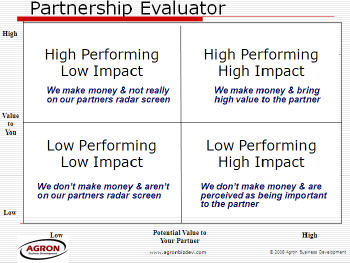Partnering is no longer an option, but a must. Most enterprise software revenue is a healthy mix of direct and indirect sources. Based on a recent study by the Association of Strategic Alliances Professionals, alliances (partnerships) will soon be generating over 40% of market value to two-thirds of 150 high technology companies recently surveyed. In fact, there is no better time than now to evaluate the state of your current partnerships and focus only on the ones that fall into two of the four categories below. Then, drop those that don't align with these two categories. Or find some new ones in which your capabilities, combined with those of your potential partner, will differentiate your offerings from those of your competition, and drive more business.
The list below is designed to help you identify and deal with four commonly encountered but very different partnership relationships and their outcomes. It will help you begin to segment the partnerships that are worth investing in, and drop the ones that are just creating a lot of activity, but not producing any revenue or other results.
This list is based on some best practices and lessons learned from having developed partnerships with all types and sizes of technology companies that span the entire partner ecosystem of Independent Software Vendors (ISVs), System Integrators (SIs), Value-added Resellers (VARs) and Original Equipment Manufacturers (OEMs).
 |
- High Performing - High Impact partnerships have the potential to be your most profitable partnerships. They often result in driving a predictable revenue stream to existing and new customers, as well as helping you expand into new markets. These partnerships share a compelling value proposition in what they deliver to end user customers and to each other. These partnerships are the most demanding, as they require a long-term development plan and investment approach to allocate the right resources to support and build a mutually profitable relationship. Action: Spend your time and resources with these types of partnerships as the payoff can be huge.
- High Performing - Low Impact partnerships are those that will provide a bump in sales volume, but your product or service offering is often considered to be more of a commodity. Being viewed as a commodity may keep you from attaining a closer relationship with these partners, because you are not perceived as providing a high impact on their business. These partnerships will tend to negotiate heavily on price and you must always be aware of the need to continue to reinforce your value proposition to them. Action: Spend your time and resources with these types of partnerships wisely and look for ways to increase your value to them so they can move over into the coveted upper right hand quadrant.
- Low Performing - Low Impact partnerships don't yield much revenue to you and you are probably not viewed by these partners as having any impact on their business. Action: The key here is to not spend a lot of time and resources with accounts in this quadrant, as what you are offering might only be seen as a "nice to have," but not a "must have" part of their solution.
- Low Performing - High Impact partnerships are typically a one-way street. What you bring to the party is considered of high value to their business, but they really don't have the market reach or ability to drive much revenue for your efforts. Hence, they are considered low performing. In these cases, only invest resources as needed to close deals. Prioritize how much time and resources you'll spend with partners in this quadrant. It's easy to get enamored with what initially appears to be a hot partnership opportunity, but in reality will take up a lot of time and resources. Action: It's better to spend your time on categories #1 and #2 above.